 Now the Giro is about to start, the details of the stage have been modified for some of them and the information available below is thus no longer correct for these stages. Please read the article The Tour of Italy 2013 race route on Google Maps/Google Earth and the stage profiles for the most up-to-date information and for very precised maps with the race route of this race!
Now the Giro is about to start, the details of the stage have been modified for some of them and the information available below is thus no longer correct for these stages. Please read the article The Tour of Italy 2013 race route on Google Maps/Google Earth and the stage profiles for the most up-to-date information and for very precised maps with the race route of this race!
As usual, RCS Sport did it with a big show with some nice graphics and the promotion of its digital strategy, the Giro d'Italia 2013 has been presented on Sunday 30 September 2012!
I've seen quite some people who were surprised about the date of the official presentation, but this can simply be explained by the fact that the Tour of Lombardy has been moved to a 15 days earlier spot in the calendar and that the presentation takes place the day after this Italian race of the UCI WorldTour (probably to facilitat the presence of riders).
Let's have a detailed look at the stages of the Giro d'Italia 2013 which seems to be a balanced Grand between mountains and time trials.
The stages of the Tour of Italy 2013 one by one
As I already told you in the introduction, RCS Sport didn't cut its budget to promote what the company itself calls the hardest race in the world which visits the most beautiful places in the world and we can for example see that in the promotion video for the 2013 edition, which will be 3,405.3 km (162.2 km per stage in average) long and composed of 2 individual time trial stages (55.5 and 19.4 km) of which the second will be a mountain stage, 1 team time trial (17.4 km), 7 flat stages, 5 medium mountain stages (of which 1 will have an uphill finish) and 5 high mountain stages, all with a mountain top finish.CONTINUE READING AFTER THIS ADVERTISEMENT
1/ Saturday 04 May 2013 - Napoli > Napoli - 156 km - flat
The first stage will be on a circuit around Naples and the coast city will thus be both start and finish city of this stage.It will be a flat stage on a circuit on which the riders will do 10 laps. After the start from the Piazza Plebiscito, they'll rapidly get to the real start of the stage at the entrance of the circuit, which is 15.6 kilometers long and which partially follows the coast line, via a small hill in Possilippo which will at the 7th and 9th crossing count for the King of the Mountains classification.
Hereunder you will find the map of the race route and the profile of this stage.
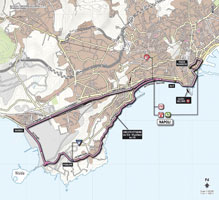
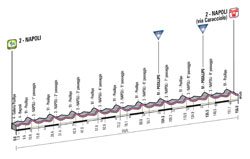
2/ Sunday 05 May 2013 - Ischia Porto > Forio - team time trial - 17.4 km
The second stage of the Giro d'Italia 2013 will take place as a team time trial on the island Ischia north of the Gulf of Naples, between the harbour of Ischia and Forio, over a distance of 17.4 kilometers. The race route is almost completely flat and will allow the teams specialised in this discipline to create some gaps in the general classification.Hereunder you will find the map of the race route and the profile of this stage.
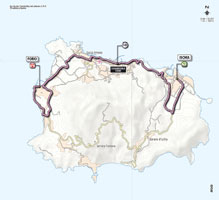
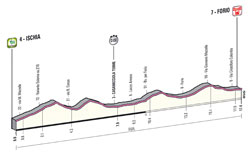
3/ Monday 06 May 2013 - Sorrento > Marina di Ascea - 212 km
Back on the continent, the riders will start from Sorrento for a middle mountain stage of 212 kilometers which will follow the coast line down to Agropoli before going a little bit more landinwards to go find the climbs of Mercato Cilento and Sella di Catona which is quite close to the finish in Marina di Ascea, again on the coast side.Hereunder you will find the map of the race route and the profile of this stage.
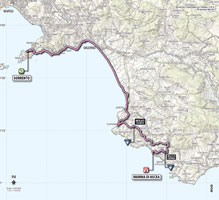
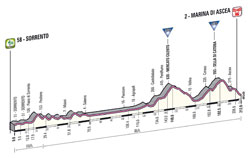
4/ Tuesday 07 May 2013 - Policastro Bussentino > Serra San Bruno - 244 km
The next day, the 4th stage will again be a middle mountain stage, over 244 kilometers this time, between Policastro Bussentino and Serra San Bruno. Between those two cities, the riders will start this stage with a flat part (over about 185 kilometers) following the coast line from north to south towards the point of the foot of Italy and than continues land inwards towards the climbs of Vibo Valentia and the Croce Ferrata at less than 6 kilometers from the finish.Hereunder you will find the map of the race route and the profile of this stage.
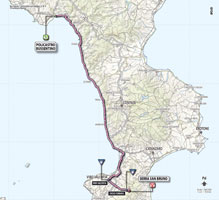
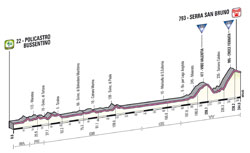
CONTINUE READING AFTER THIS ADVERTISEMENT
5/ Wednesday 08 May 2013 - Cosenza > Matera - 199 km
After a transfer of 120 kilometers, the 5th stage will start in Cosenza and it will be a flat stage over 199 kilometers. It does however contain 2 climbs which are part of the King of the Mountains classification and one other short climb. The two climbs are quite far away from each other: Spezzano Albanese after 45.5 kilometers and Montescaglioso 133 kilometers further. They are not really important enough to prevent the sprinters from a battle on the finish line in Matera though.Hereunder you will find the map of the race route and the profile of this stage.
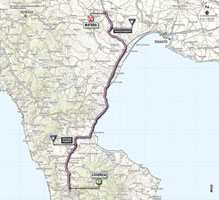
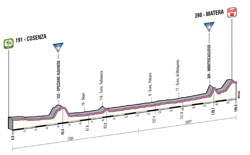
6/ Thursday 09 May 2013 - Mola di Bari > Margherita di Savoia - 154 km
The 6th stage is again a flat stage which will start on the sea side in Mola di Bari.The stage will follow the coast line up to Barletta and continue with a short visit land inwards via Andria and Canosa di Puglia before it gets back sea side towards the finish in Margherita di Savoia. The finish line will be drawn close to the beach but the riders will still have to do a 16.1 kilometer long lap around the city.
There will be no difficulties in this stage and it's thus quite probable that this stage will again end in a sprint ... except if a breakaway manages to stay away?
Hereunder you will find the map of the race route and the profile of this stage.
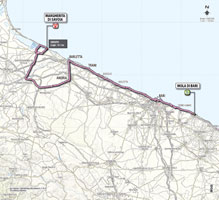
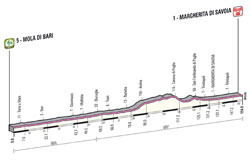
7/ Friday 10 May 2013 - San Salvo > Pescara - 162 km
After the 6th stage the riders and followers of the Tour of Italy 2013 will do a 170 kilometer long transfer and get back together in San Salvo for the start of the 7th stage which will be a middle mountain stage.Indeed, this stage is hilly from start till finish but it's only in the latter third of the stage that the riders can go find the points for the King of the Mountains classification in no less than 4 referenced climbs in only 40 kilometers. Those are the climbs of Chieti-V. Fieramosca, Chieti-Tricalle, Villa Delgi Ulvi and finally San Silvestro. The finish will be in Pescara at about 6 kilometers from the top of the last climb.
Hereunder you will find the map of the race route and the profile of this stage.
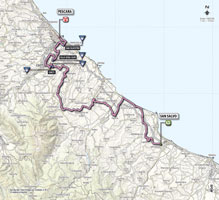
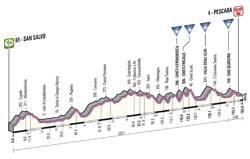
8/ Saturday 11 May 2013 - Gabicce Mare > Saltara - individual time trial - 55.5 km
On Saturday 11 May, after a transfer of no less than 215 kilometers, an individual time trial is on the programme of this 96th edition of the Giro d'Italia. The race route of this time trial is quite flat between Gabicce Mare and Saltara. The distance of 55.5 kilometers will give the specialists de of the solo effort a little bit over an hour to take back some time on their competitors in the general classification.They can compare their intermediate timing to the one of their competitors when they cross Pesaro.
Hereunder you will find the map of the race route and the profile of this stage.
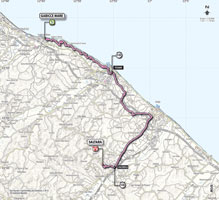
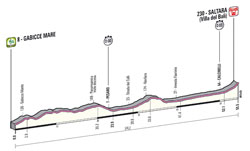
CONTINUE READING AFTER THIS ADVERTISEMENT
9/ Sunday 12 May 2013 - Sansepolcro > Firenze - 181 km
After this solo effort, a transfer of 110 kilometers is necessary to get to the start of this 9th stage in Sansepolcro. This 9th stage again is a middle mountains stage, over a distance of 181 kilometers, which will go up the Passo della Consuma, the climb of Valombrosa, the one in Vetta le Croci and finally the one in Fiesoli. Ten kilometers after the top of this last climb, the finish line will be drawn in Firenze.Hereunder you will find the map of the race route and the profile of this stage.
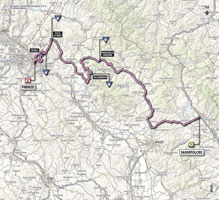
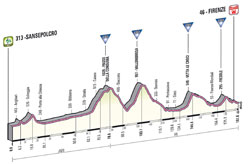
R1/ Monday 13 May 2013
Before they get to the high mountains the next day, the riders can - after 9 stages - get some rest close to Cordenons, at a bit over 330 kilometers from the finish the day before!10/ Tuesday 14 May 2013 - Cordenons > Altopiano del Montasio - 167 km
The first high mountains stage which will - just like all high mountain stages of this Giro - finish uphill, starts almost easily after the start from Cordenons, with a gradual climb towards the foot of the Passo Cason di Lanza which is at 103.3 kilometers from the start and which has its top 14.5 kilometers further (1048 meters of altitude difference with an average steepness of 8.5% and a maximum of 16%).The descente of this climb goes on in the final climb towards the top of Altopiano del Montasio, a climb which is 10.4 kilometers long with an altitude difference of 841 meters and an average steepness of 8.1% with a maximum of 20%!
Hereunder you will find the map of the race route and the profile of this stage.
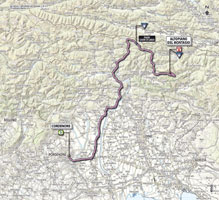
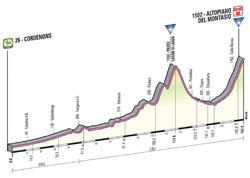
11/ Wednesday 15 May 2013 - Tarvisio (Cave del Predil) > Vajont 1963/2013 (Erto e Casso) - 184 km
The 11th stage will start in Tarvisio just next to the previous finish city and this will be a medium mountain stage with a distance of 184 kilometers and will start with a descent down to the foot of the Sella Campigotto 88 kilometers from the start.This is not the only difficulty however because this stage ends uphill, in Vajont, and with this finish the Giro will remember a landslide which took place on 9 October 1963.
Hereunder you will find the map of the race route and the profile of this stage.
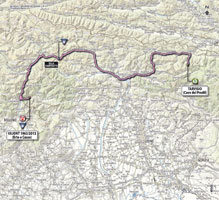
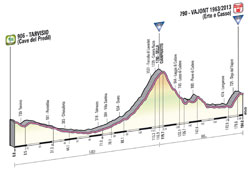
CONTINUE READING AFTER THIS ADVERTISEMENT
12/ Thursday 16 May 2013 - Longarone > Treviso - 127 km
After these pretty difficult stages, this 12th stage will again be a flat stage and it will be short as well, between Longarone and Treviso.Two climbs are part of this stage: the Muro di Ca' del Poggio and the Montello Santa Maria della Vittoria.
Hereunder you will find the map of the race route and the profile of this stage.
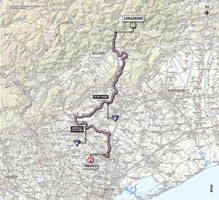
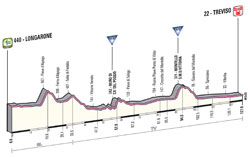
13/ Friday 17 May 2013 - Busseto > Cherasco - 242 km
After a transfer of 180 kilometers, the riders get to the start of this 13th stage on this Friday 17 May 2013 (that's a lot of 13 for a Friday, not good for the superstitious riders!) in Busseto for another flat stage, long this time with its distance of 242 kilometers. That means it's longer than the usual maximum distance of a stage in a Grand Tour, so the Giro had to ask for an exception for this stage.This stage starts flat but after 190 kilometers the riders will get on a short climb in Diano d'Alba. The end of the stage is slightly hilly until the finish in Cherasco.
Hereunder you will find the map of the race route and the profile of this stage.
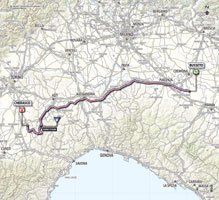
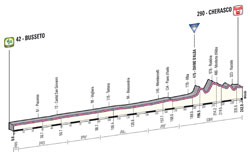
14/ Saturday 18 May 2013 - Cervere > Bardonecchia (Jafferau) - 156 km
The 3rd weekend of the Giro d'Italia 2013 will see two high mountain stages following up on each other, starting with the one between Cervere and Bardonecchia. After 75 kilometers the riders will start the climb of Sestrière which will have its summit after 113 kilometers in the race and at an altitude of 2035 meters.After the descent of this climb, the final climb will start at 7.25 kilometers from the finish and will go up 625 meters with an average steepness of 9% and a maximum of 14%.
Hereunder you will find the map of the race route and the profile of this stage.
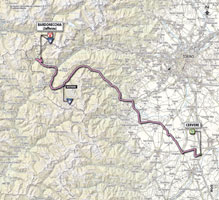
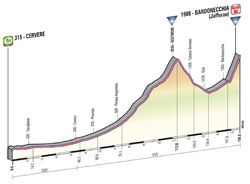
15/ Sunday 19 May 2013 - Cesana Torinese > Col du Galibier (Valloire) (FR) - 150 km
The 15th stage will mainly take place in France because after 51 kilometers, in the climb towards the top of the Col du Mont Cenis, the riders will cross the border.After the descent of the Mont Cenis via Modane, the riders will get on the Col du Télégraphe which goes on in the Col du Galibier, well known for the Tour de France, and the finish will be on top of this last climb.
This stage is one of the hardest stages of this Tour of Italy 2013!
Hereunder you will find the map of the race route and the profile of this stage.
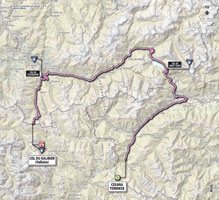
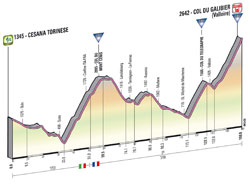
CONTINUE READING AFTER THIS ADVERTISEMENT
R2/ Monday 20 May 2013
After those two difficult stages, it's time to get some rest in France, in Valloire.16/ Tuesday 21 May 2013 - Valloire (FR) > Ivrea - 237 km
The day after the second rest day, the start of this stage will be in Valloire as well.The riders will however not stay in France for a long time: they'll climb a short part of the Col du Télégraphe and redescend towards Saint-Michel-de-Maurienne where they again go via Modane up the Col du Mont Cenis. In the descent of the Mont Cenis they'll get back in Italy and the rest of the stage is relatively flat until about twenty kilometers from the finish where a short but steep climb towards Andrate will be on their road before the finish in Ivrea.
Hereunder you will find the map of the race route and the profile of this stage.
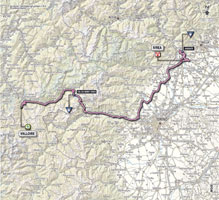
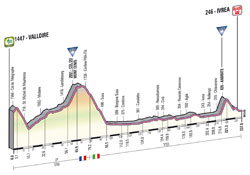
17/ Wednesday 22 May 2013 - Caravaggio > Vicenza - 203 km
The 17th stage will bring back the riders on a flat road: this stage is flat as a pancake from the start in Caravaggio over at least 180 kilometers.A short climb in Crosara will have its summit at 15 kilometers from the finish in Vicenza.
Hereunder you will find the map of the race route and the profile of this stage.
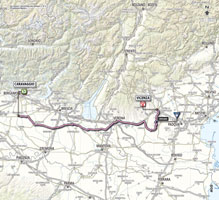
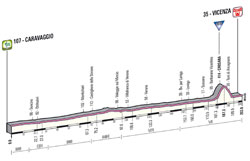
18/ Thursday 23 May 2013 - Mori > Polsa - uphill individual time trial - 19.4 km
This Thursday a new individual time trial will be on the programme of the Giro. This will however not just be a simple time trial because it's what the Italian organisers call a cronoscalata, that is an uphill time trial.19.45 kilometers long, the stage goes uphill right from the start in Mori, in a regular way with a 6.1% steepness until the intermediate timing point in Brentonico, followed by a little bit flatter part and again a climb with an average steepness of 6.8% - which has a maximum at 10% - until the finish in Polsa. An altitude difference of 1008 meters gives an average global steepness of 5.2%.
Hereunder you will find the map of the race route and the profile of this stage.
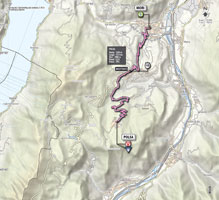
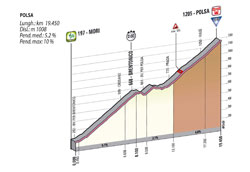
CONTINUE READING AFTER THIS ADVERTISEMENT
19/ Friday 24 May 2013 - Ponte di Legno > Val Martello/Martelltal - 138 km
Even though this stage is only 138 kilometers long, it still is one of the toughest stages of the Giro d'Italia 2013 with the successive climbs of Ponte di Legno/Passo di Gavia (16.5 km for an altitude difference of 1320 meters and thus an average steepness of 8% going up to 16% maximum), the Passo dello Stelvio (21.7 km for an altitude difference of 1553 meters and thus an average steepness of 7.2% going up to 12% maximum) and the final climb towards Val Martello, 22.3 kilometers long for an altitude difference of 1422 meters and thus an average steepness of 6.4% going up to 14% maximum.Hereunder you will find the map of the race route and the profile of this stage.

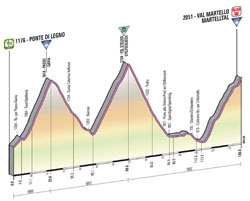
20/ Saturday 25 May 2013 - Silandro/Schlanders > Tre Cime di Lavaredo (Auronzo di Cadore) - 202 km
The stage the day before the final finish of this Giro d'Italia 2013 is again a high mountain stage, which starts in Silandro.After 64 kilometers pretty much going downhill, the riders will climb several mountains, starting with the Passo Costalunga (Karerpass) followed by the Passo di San Pellegrino (11.8 km for a 753 meters altitude difference and thus an average steepness of 6.4% going up to 14% maximum).
A bit further, the next climb will be the Passo Giau (15.65 km for a 1259 meters altitude difference and thus an average steepness of 8% going up to 14% maximum) and the Passo Tre Croci (7.95 km for a 580 meters altitude difference and thus an average steepness of 7.3% going up to 12% maximum) immediately followed by the final climb to Tre Cime di Lavaredo (Auronzo di Cadore) (7.05 km for a 607 meters altitude difference and thus an average steepness of 8.6% going up to 18% maximum!) which will most probably allow for magnificent TV images world wide!
Hereunder you will find the map of the race route and the profile of this stage.
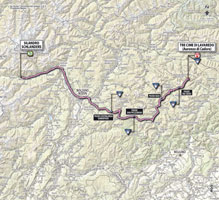
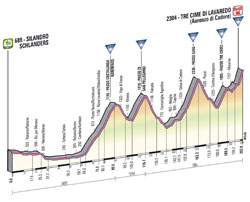
21/ Sunday 26 May 2013 - Riese Pio X > Brescia - 199 km
The last stage is completely flat between Riese Pio X and Brescia. The riders will get to the finish line for the first time after 165.5 kilometers but they'll still have 5 laps to do on a circuit which is 6.7 kilometers long, before they cross the finish line for the very last time and thus before we know the name of the rider who wins this final stage, most probably a sprinter. There will most probably not be much suspense anymore for the overall winner of the Giro d'Italia 2013 general classification: that'll probably be the rider who wears the pink jersey at the end of the previous stage!Hereunder you will find the map of the race route and the profile of this stage.
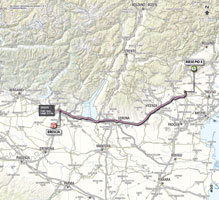
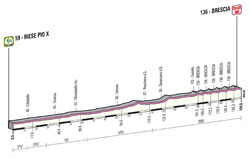
The overall map of the Giro d'Italia 2013
Hereunder you can find the full map of the Tour of Italy 2013 with all these 21 stages!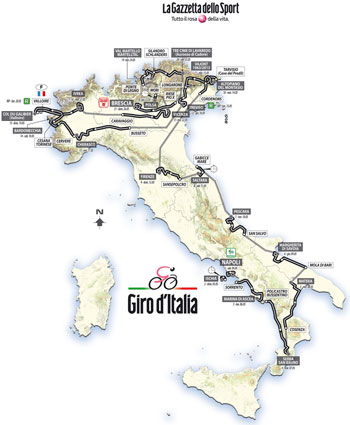
The video of the presentation of the stages of the Giro d'Italia 2013
If you have a little bit over 10 minutes to spend and if you want to see all details of the different stages in a video, click on the "play" button below!The teams which will participate in the Giro d'Italia 2013
The Giro d'Italia is a race which is part of the UCI WorldTour 2013 and it's thus not surprising that the 18 UCI ProTeams (of which we will know the final list in a few weeks) will participate in this race.4 wildcards will than still be available and usually the organisor is completely free to chose the team they want. However, this year for the first time, RCS Sport signed an agreement with the Federazione Ciclistica Italiana which will run for at least two years and which obliges the Italian organisor to automatically award a wildcard to the team which wins the teams classification of the Coppa Italia di ciclismo.
While the Coupe de France PMU is pretty unknown in France, the mediatisation of the Coppa Italia di ciclismo seems to be even less in Italy. That might actually be the reason why the Italian cycling federation wanted to sign this agreement!
But what is the Coppa Italia di ciclismo? It is, just like the Coupe de France PMU, a national calendar which gathers together a certain number of cycling races in Italy. To be more precise, all Italian races of the HC and 1st classes of the UCI Europe Tour are part of it.
Last year, the team which would have been automatically selected if this agreement were to apply at that time already, was Androni-CIPI based on 27 races. On 25 September 2012, the Androni Giocattoli-Venezuela team was leading this classification and it still was after the final race.
If the same principle existed in France, the Bretagne-Schuller would today have the guarantee to participate next year in the Tour de France! (the Tour de Vendée still had to take place at the time of publication of this article but since their gap on number 2, Saur-Sojasun, exceeds 12 points the team from Brittany is already sure it will win the classification)
The list of races, found thanks to the search engine of the interactive UCI cycling calendar on velowire.com, shows that 3 races still remain at the time of publication of this article and that the two races which took place on 26 and 27 September have not yet been taken into account in this classification.
Here's the complete list of races:
1.HC & 2.HC
Tour of Trentino (Giro del Trentino) from 17-04-2012
Tre Valli Varesine on 18-08-2012
Milan-Turin (Milano-Torino) on 26-09-2012
Giro del Piemonte on 27-09-2012
Giro dell'Emilia on 06-10-2012
1.1 & 2.1
G.P. Costa degli Etruschi on 04-02-2012
Giro della Provincia di Reggio Calabria-Challenge Calabria from 11-02-2012
Trofeo Laigueglia on 18-02-2012
Strade Bianche on 03-03-2012
Settimana Internazionale Coppi e Bartali from 20-03-2012
Giro dell'Appennino on 15-04-2012
GP Industria & Artigianato on 28-04-2012
Giro della Toscana on 29-04-2012
Trofeo Melinda - val di Non on 02-06-2012
GP Nobili Rubinetterie Coppa Citta di Stresa on 14-07-2012
Trofeo Matteotti on 29-07-2012
G.P. Camaiore on 11-08-2012
GP Banca di Legnano - Coppa Bernocchi on 16-08-2012
Coppa Agostoni - giro della Brianza on 17-08-2012
GP Industria Commercio Artigianato Carnaghese on 23-08-2012
Giro del Veneto-Coppa Placci on 25-08-2012
Giro di Padania from 03-09-2012
Memorial Marco Pantani on 15-09-2012
GP Industria & Commercio di Prato on 16-09-2012
Gran Premio Città di Peccioli - Coppa Sabatini on 04-10-2012
Gran Premio Bruno Beghelli on 07-10-2012
(thanks to Serena Moranzoni for her help in finding all information about this calendar and its classification!) door Thomas Vergouwen
Vond u dit artikel interessant? Laat het uw vrienden op Facebook weten door op de buttons hieronder te klikken!
25 comments | 67357 views
this publication is published in: Giro d Italia | Giro d'Italia 2013





 by marco1988 over
by marco1988 over
Le Giro de 2013 semble marquer la rupture, comme l'avait annoncé le nouvel organisateur de la course. Je trouve la course bien faite, niveau trajets ça ne me choque pas trop, et la dernière semaine devrait promettre de belles bagarres!
@Guillaume, je me suis permis de déplacer votre commentaire sous cet article dédié au Giro 2013.
Magnifique parcours, avec 5 superbes arrivées en altitude, des étapes de montagne de folie, 2 gros chrono (très bien!), l'arrivée en haut du Galibier pas son VRAI côté (pas celui d'ASO), de la moyenne montagne.
Un vrai parcours de grand tour avec du spectacle en perspective.
Il manque peut être une arrivée en bas d'un col (encore que, car généralement, cela a pour conséquence de figer la course, voir TDF).
Je trouve que la manière de présenter ce Giro (vidéo trailer + présentation du tracé" est vraiment moderne, magnifiquement présenté. Cela change du classicisme d'ASO, ça montre une envie de casser les codes chez RCS.
De plus le Giro n'hésite plus à se présenter comme "la course la plus difficile dans le plus bel endroit du monde". Il y a des années le TDF avait cette réputation mais le rapport de difficulté s'est inversé. Le Giro sait se vendre, contrairement au TDF qui reste sur ses acquis.
Bonjour à tous. Je crois que l'on va se régaler avec ce Giro (comme à chaque fois).
@Thomas: Petit commentaire concernant l'étape qui arrive à Vajoint. Ce n'est pas un tremblement de terre qui a eu lieu à cet endroit en 1963. En fait, c'est une grosse partie de la montagne qui s'est décrochée et qui est tombée dans l'eau du barrage. Cette terre a provoqué une vague gigantesque qui a touché les deux villages situés bien au dessus du niveau de l'eau, puis l'eau est passée au dessus du barrage (toujours intact) et a englouti les villages de la vallée provoquant des milliers de morts. Actuellement le plan d'eau est de 3/4 recouvert de terre et gravas dans sa partie aval, contre le barrage. Impressionnant...
Beau parcours que celui de ce Giro 2013, avec, tout de même, quelques petites remarques :
- les "7 stages for sprinters" présentées dans la vidéo présente pour au moins 2 d'entre elles, des finals très difficiles pour les sprinteurs : Matera et Vicenza, les étapes de Naples (en circuit -> très bonne idée)et de Cherasco sont également piégeuses !
- ce qui me marque, c'est le faible nombre d'étape de haute montagne (5 si on excepte celle de Vajont qui a l'air d'emprunter un sacré col au milieu) pour un Giro, et c'est tant mieux ! Elles sont bien dessinées mais elles arrivent toutes en altitude, une arrivée en descente (voire 2) aurait eu sa place -> l'enchaînement Gavia-Stelvio et arrivée en bas, par exemple ...
- la trop haute altitude : beaucoup de cols ou d'arrivées au-dessus des 2000 m, si la météo s'en mêle, on pourrait, dans un scénario catastrophe, avoir plusieurs étapes annulées ...
Sur le papier, il offre pas mal de satisfactions, moins dur que les précédents, il pourrait attirer les plus grands (Wiggins, Contador ?) sans que ceux-ci ne mettent une croix définitive sur le Tour 2013 ...
Bonne journée,
Elie.
Une arrivée au sommet du Galibier le 19 mai c'est risqué. La DDE va devoir déneiger plus tôt que d'habitude (si les conditions le permettent).
Le Guardian a annoncé que Wiggo ferait probablement l' impasse sur le Tour.
@Alain66 : merci pour l'info, je vais corriger ça dès que possible (ce soir probablement). Ma maîtrise de l'Italien est vraiment mauvaise ;-).
@Elie : en ce qui concerne les "7 stages for sprinters", j'avais fait exprès de ne pas reprendre cette appellation puisque j'étais comme toi, je ne la trouvais pas adaptée à certaines étapes. Au début je pensais à un problème de traduction, mais même en Italien RCS parle de 7 tappe per velocisti, ce qui veut dire exactement la même chose ... c'est surprenant ! En réalité il s'agit simplement de ce qu'on appellerait 7 étapes de plaine.
Parcoues plus équilibré, je préfere... reste des transferts très importants et que les étapes de haute montagnes se terminent toutes en hauteurs, c'est regrettable, sur 5 étapes de haute montagne, 2 arrivées en vallées auraient été judicieuses. Heureusement la moyenne montagne n'est pas touchée par la multiplication des arrivées au sommets !
Ok Thomas pas de soucis merci :)
@Thomas : Pas de problème. C'est en fait un glissement de terrain du aux fortes pluies qui a causé cette catastrophe sur le plus grand barrage d'Europe (à cette époque). Un film a été fait en 2001 "La Folie des Hommes" avec Daniel Auteuil et Michel Serrault. Le départ du lendemain a lieu dans la vallée, à Longarone (Village sinistré) où se trouve un mémorial dédié aux victimes.
Je peux en parler un peu car j'ai visité le site avec des amis Italiens il y a quelques années, mais je reconnais que je ne connaissais pas cet évènement avant.
@ Likinto : Pour cela, il faudrait que Prudhomme fasse son boulot d'organisateur de course cycliste.
Et pas seulement un job de business man / représentant de commerce / metteur en scène d'une course de vélo à suspense.
Sur ce Giro, je ne suis pas d'accord avec Dom (pour changer ^^)
Personnellement, ça reste dans la logique 2011 et 2012. Malgré que ça se calme en haute-montagne, le parcours reste déséquilibré avec beaucoup d'étapes accidentées et finalement peu d'opportunités claires pour les sprinteurs (4, 6 pour ceux qui passent vraiment bien les bosses).
Dans le détail, il beaucoup d'arrivées en altitude. Il y a certes moins d'étapes de montagne (6, en content le chrono en côte, ce qui n'est pas un nombre faible Elie), mais ces 6 là arrivent en altitude. Il faut aussi ajouter les étapes de moyenne montagne à Vajont et Serra San Bruno (suivi d'un léger plat) pour porter à 8, un chiffre similaire à 2011 et 2012. Sur le plan individuel, toues les étapes sont cela dit bien tracées. Mais comme d'habitude je regrette l'absence d'arrivée en descente car, pour paraphraser Dom, cela ne fige pas la course mais augmente carrément la longueur du spectacle puisque ça oblige les coureurs à attaquer de plus loin (cf. Grand-Bornand 2009, Grappa et Madeleine 2010). C'est dommage, il y avait la place, notamment sur le Galibier. Je ne suis pas fan des arrivées sur le cols, en particulier aussi haut, et je ne considère pas cette arrivée comme le maximum atteignable avec le Galibier. ASO avait fait petit, le Giro vise un peu mieux, mais le must ça resterait une ascension nord et une arrivée en descente en haut de Serre-Chevalier (au Monetier-les-Bains). Au lendemain de la courte montée sur le Jafferau, ça aurait offert un parfait duo d'étapes. Mais bon c'est Valloire qui a eu son ticket donc... Autre souci en montagne, c'est entre les deux dernières étapes celle du Gavia-Stelvio et de Tre-Cime di Laveredo. Elles sont très bien pour finir la montagne mais à deux elles se marchent dessus et le Gavia-Stelvio ont toute chances d'être escamotés. J'ai une solution et j'y reviendrai.
Question gros chrono, alors moi j'en vois un, celui de Saltara. Les médias font déjà leur foin avec Wiggins en parlant de 88kms, mais il n'y a que 55km qui lui sont favorables. Il reste 19km en montagne et 18 km de TTT, ce qui est très court pour l'exercice (~10 relais par coureur). Cela dit, ça fait plaisir de retrouver un vrai chrono sur le Giro, les 35km milanais tenant plus de l'exercice de récupération que de l'exercice de style.
Dernier point qui fâche, comme d'habitude, les transferts. Je me pose vraiment des questions pour ceux que ça ne choque pas. Le début est nickel mais à partir de Matera c'est parti pour les 200km journaliers, avec en apothéose le triple passage en plaine du pot, qui fait passer la carte de la Vuelta 2012 pour claire par rapport à celle du Giro 2013. Le tracé est trop fouilli, et je ne comprend pas ce crochet vers la Vénetie...
On pouvait faire le repos à Florence, une étape de plat vers le golfe de Ligurie, puis la premier arrivée en altitude dans les Appenins du Nord (San Pellegrino in terme par exemple) et rattraper le tracé à Busseto avec une étape en réserve (celle de Vajont), ce qui décale le repos à Ivrea. je repars en utilisant mon étape joker jusqu'à Caravaggio. Ensuite Vicenza puis le chrono en côte. Ayant supprimé Stelvio-Gavia, je repars de Trento (transfert minime) vers les Tre Cime di Lavaredo, avancée d'un jour. Le lendemain, dernier samedi, je rajoute une étape pour les dernières offensives entre Cortina et Vajont (via Falzarego, Duran, Vajont) qui assure l'hommage, un transfert plus court et remplace numériquement celle du Stelvio. Résultat un tracé avec moins de transfert et un intérêt sportif plus élevé : un sprint en plus (ça rééquilibre le tout) et une étape de haute-montagne en moins ce qui renforce l'importance des étapes accidentées, qui sont beaucoup plus nombreuses elles.
Dernière remarque sur la com'. La présentation est en effet très moderne et efficace. Sur le reste, je remarque juste (une nouvelle fois) que quand RCS fait de la com' sur le côté sportif de son tracé c'est vu positivement (là où Prudhomme se fait tacler pour le Ventoux 2009, le Tourmalet 2010 et le Galibier 2011) et quand ils mettent l'accent sur l'Histoire et le patrimoine, on dit qu'ils savent vendre (là où certains sont au bord de la révolte pour "une semaine de plat" en 2013 (ndlr 5 jours !) qui va nous faire visiter St-Malo, le MSM et les chateaux de la Loire). Il ne faut pas oublier que les racines de la com' italienne, c'est son gros complexe d'infériorité par rapport au Tour qui se manifestent dans "la guerre de qui a la plus grosse" (le Stelvio et le Galibier réponde au Galibier 2011) et dans la date de la présentation que RCS a replacé avant celle du Tour depuis 2 ans !
@Svam : commentaire un peu long ... je relève juste que visiblement vous avez consulté le site de L'Equipe pour parler des 88 kilomètres de contre-la-montre.
Si L'Equipe parle de 88 kilomètres à pas moins de 4 reprises, ça ne choque personne ? Personnellement ça me choque ... Ou alors, c'est que ma calculatrice utilise une autre dimension que celle de L'Equipe. Moi je vois :
- contre-la-montre individuel : 55,5 + 19,4 = 74,9 km
- contre-la-montre par équipe : 17,4 km
Si on additionne les deux (mais quel intérêt d'additionner l'individuel avec l'équipe .. ce n'est pas du tout la même chose !) pour essayer de retrouver les 88 de L'Equipe, on arrive au mieux à 92,3 kilomètres ...
Conclusion : c'est moi ou L'Equipe qui a tout faux ? Tout comme tous ceux qui parlent de 7 arrivées en altitude d'ailleurs ... RCS en annonce 6, pas 7 !?
Ouais, c'est lequipe.fr effectivement. J'avais même pas pensé à vérifier, tellement l'idée même d'additionner m'avait choqué. Il y a 3 étapes contre-la-montre, toutes dans un style différent, donc ça ne s'additionne pas même pour les individuels (Si Cancellara met 6' à Purito sur les 55kms plats, il en reperd 3 à 4 sur les 19 d'ascension).
Concernant les arrivées en altitude, il y a les 6 étapes de haute-montagne, auquel on peut ajouter Vajont (moyenne montagne) et auquel j'ajoute celle de l'étape 4 (l'arrivée se situe après un faux-plat descendant de 6km, ce qui rappelle les conditions du Lago Laceno cette année (le jour où Rodriguez a manqué de gagner le Giro))
Effectivement, pour ne pas trop critiquer je n'ai rien dit sur le fait d'additionner les individuels, mais effectivement Cancellara n'a pas la même performance sur un parcours plat qu'en montée ! Et ce n'est qu'un exemple, les deux CLM sont tout sauf comparables.
Pour les arrivées au sommet : il y a 5 étapes de haute montagne et une arrivée au sommet de plus à Vajont effectivement. L'étape 4 n'est pas une arrivée au sommet.
Alors que je pensais que tout le monde allait se déchaîner sur ce parcours de Giro (comme chaque octobre contre le tracé du Tour), je lis les commentaires, et là surprise : que du positif. Aucune (ou peu) de critique contre le peu d' étapes pour sprinteurs, l'hégémonie (malheureusement habituelle sur le Giro) des arrivées en altitude sur la haute montagne, l' absence totale d'enchaînements de cols sur la fin des étapes (Jafferau, Altopiano, Val Martello) et cerise sur le gâteau, sur les hallucinants transferts. J' aimerais vraiment que vous m'expliquiez en quoi ce tracé est meilleur que celui du Tour version 2012.
Le nouveau design de la présentation ne saurait faire oublier les importantes lacunes de ce premier tracé sauce Acquarone, très décevant pour moi. Alors, oui, certes, je suis content de retrouver un clm digne de ce nom sur un Giro (même si celui-ci est peut-être là pour de mauvaises raisons : attirer Wiggins), de cette ascension du Galibier par le nord et de voir les Tre Cime di Lavaredo, mais 3 étapes réussies, c'est peu sur 21.
Là où Zomegnan (loin d'être un exemple pour moi) disséminait les difficultés sur 3 semaines, Acquarone a décidé de s'inspirer de notre Prudhomme national sur ce qu'il a fait de plus criticable (il a d'ailleurs désormais abandonné cette idée) : la politique du suspense à tout prix. Comme l'année dernière, les grosses étapes sont regroupées sur la fin de Tour. Cependant, alors que 2012 comprenait des manches montagneuses quasiment exemptes de défauts (hormis l'étape du Stelvio mais comme c'était la dernière étape de montagne, ça ne portait pas trop à conséquences), 2013 présente des étapes qui se résumeront jour après jour à des courses de côtes, cela alors que la botte est un paradis pour traceurs de parcours (là où la péninsule ibérique est beaucoup moins apte aux bons tracés). Tout cela pour dire que, pour une fois (et je remercie Acquarone pour cela), le tracé du TDF 100ème du nom risque fort d' être supérieur, voire largement supérieur, à celui de ce Giro, peu engageant à mes yeux.
D'un point de vue global, ce Giro est équilibré. Je le décortique de la manière suivante :
3 étapes CLM
5 étapes de plaine (Napoli, Matera, Marguerita di Savoia, Trevisio, Cherasco, Brescia)
3 étapes accidentées (Marina di Ascea, Pescara et Vicenza)
4 étapes de moyenne montagne (Serra San Bruno, Firenze, Vajont et Ivrea)
5 étapes de montagne (Altopiano del Montasio, Bardonecchia, Galibier, Val martello Martelltal et le Tre Cime di Lavaredo)
Difficile donc de faire plus équilibré.
Les gros points noires, comme déjà souligné concernent les transferts, et le fait que les 5 étapes de montagne arrivent au sommet. On dirait que c'est la nouvelle mode de ne faire que çà, sous prétexte qu'une descente refroidirai les ardeurs des attaquants.
Concernant les étapes pour sprinteurs, je trouve leurs nombres bien suffisants, surtout si l'on ajoute les 3 étapes accidentées, où quelques sprinteurs pourraient passer. Cela fait entre 25 et 35% des étapes réservées pour à peine 10% des participants. C'est largement suffisant. Et je ne plaindrais jamais les sprinteurs qui sont de toute manière gâtés tout au long de la saison.
Concernant la moyenne et haute montagne, ce que je trouve étrange, c'est qu'hormis l'étape de l'Altopiano del Montasio, il n'y a aucun col entre 1000m et 1900m. On est soit en dessous, soit en dessus. Et comme le souligne AT, seules les 2 dernières étapes de montagne propose un véritable enchaînement de plus de 2 cols (en consifdérant Télégrpahe + Galibier commme une seule montée). Je trouve cela dommage.
En fait je pense que j'aurais simplement rajouté une grosse étape dans les Appenins, bien escamotés cette année.
@AT
J'espère vraiment que tu auras raison pour le Tour 3013
Sinon c'est vrai qu'en étudiant de prêt les étapes , il n'y à que 2 étapes pour pur sprinteurs Margherita di Savoia et Breschia, car en dehors des étapes de montagne , toutes les étapes contiennent des pièges .
Comme tous , déçu des étapes de montagne qui se ressemblent a peut prêt toutes , comme sur la Vuelta les arrivées seront toutes en altitude et on devrait assisté à pas mal de course de côte , à la seule différence avec la Vuelta c'est qu'on aura des cols de passage vraiment difficile et le déroulement des étapes pourrait changer par rapport au tour d'Espagne , Cason di lanza , Sella Campigotto , Mont Cenis , Gavia , Stelvio , Costalunga , Giau se sont vraiment de gros morceau .
Par contre je paris que le Tour n'aura par des étapes de moyenne montagne comme au Giro , je les adorent en Italie , très diversifié , Marina di Ascea , Serra San Bruno , Pescara ( énorme celle là ) , Firenze ( avec le final du circuit du prochain championnat du monde ) , Cherasco , Ivrea ( attention à la monté de Andrate 6 km à 8,5 % ).
Pour ceux et celles qui n'auraient pas eu l'occasion de voir la présentation du Giro d'Italia 2013 en direct et qui souhaiteraient la revoir, rendez-vous sur cette page où vous pouvez la revoir en entier !
Bonjour.
La présentation du Tour d'Italie (que j'avais "anticipée" sur le blog des tours fictifs "Giro 2013-Tour 2013" il y a environ une semaine) m'inspire des sentiments nuancés.
La "charpente" des étapes est bonne (j'aurais préféré un positionnement un peu plus tardif du long crono individuel en plaine : après Vajont)), le dessin des étapes (prises individuellement ) est bon (sauf Vajont). En revanche, il manque (au moins) une arrivée en descente en haute montagne. Enfin, meme si c'est "moins mal" qu'en 2011 et 2011, trop de transferts subsistent, ce qui semble devenir un "must" de mauvais gout (que personne ne relève lors des présentations !) au niveau des grands tours. Quitte à paraitre "nostalgique", je regrette les belles cartes du Giro et du Tour d'antan avec des "pointillés" rares ....
Svam suggère pour mettre en valeur le Galibier-nord en traçant la ligne à Le Monnetier (18km voir un de mes parcours fictifs publié ancien). Ok, mais RCS pouvait difficilement ne pas saisir la "perche" Valloire et marquer les esprits avec cette première arrivée sur le versant mythique du col référence des Alpes françaises.
Il semble que la rumeur sur 3 arrivées dans dans ces confins en 5 ans prennent une certaine consistance. Les parcours fictifs fleurissent :
La Thuile - Alpe d'Huez en 2015 (Piccolo San Bernardo/Madeleine/Glandon) et Pinerolo - Les Deux Alpes 2000 (!?) en 2017 avec
Sestrières/Mongenivro/Lautaret/Sarennes) pour varier les genres.
Cela fait (à juste titre) grincer des dents au pays de Dante (ces "accords" triennaux avec des régions de France et d'Autriche).
J'aurais préféré une arrivée en descente à Trafoi (quitte à dessiner une étape courte avec Gavia et Stelvio, exit la montée du Paradiso del Cevedale pourtant "usante") , et j'aurais renforcé l'approche vers le Monte Jafferau (Muni, Finestre) en contre-partie, dans une région pas toujours exploitée à fond.
L'étape vers les Tre Cime di Lavaredo est parfaite meme si je déplore que, à chaque arrivée nouvelle au rifugio di Auronzo, l'altitude diminue de 2406m en 1981, 2320m en 2007, 2304m en 2013 avec l'abandon du "mur" terminal de 500m à 22%. Je conteste qu'il s'agisse du seul enchainement de cols sur la fin.
L'étape en France constitue un "binome" (Télégraphe-Galibier). Dans le cadre du Tour, les deux cols (5km de descente suivi du faux-plat après Valloire) ont ces dernières années toujours figuré au GPM au meme titre que Romme-Colombière (6 km de descente et remontée directe) considéré comme référence.
Les arrivées au sommet sont toutes sélectives, les étapes de moyenne montagne piègeuses, les cronos variés. Il est équilibré.
Libre à certains de préférer "Mollard-Toussuire", "Aspin-Peyresourde" ou "Peyresourde-Peyragudes" en juges de paix, des cols pentus à 40 km de l'arrivée, le tout "massacré" par 96 km de crono individuel plat (je n'oublie pas la Planche des Belles Filles et Porrentruy : à reproduire).
A ce niveau là, le débat ne m'intéresse pas, je me suis exprimé clairement sur le Tour 2012.
Le tracé du Giro 2013 est plusieurs échelons (ce n'est pas difficile) au-dessus.
Salutations.
vous savez ce qui fait la beauté d'un tour c'est la montagne c'est encore peu
Ce Giro a commencé sur les chapeaux d'roues avec des attaques tous azimuts. Merci aux coureurs qui font le spectacle parce que j'en arrivais à m'ennuyer un peu de voir une échappée, la maîtrise de cette échappée par le peloton et juste des attaques dans le dernier kilomètre. Je sais qu'il n'est pas possible de voir des courses à rebondissements tous les jours, le cyclisme c'est difficile surtout sur des grands tours. Donc merci à eux
Bongiorno.
Le Tour d'Italie 2013 va éteindre ses lampions cet après-midi, et sauf énormes surprises, l'étape se déroulera sur l'itinéraire prévu tandis que Vincenzo Nibali endossera un ultime maillot rose indiscutable.
A ceux qui font la fine bouche concernant l'opposition rencontrée, j'invite à reconsidérer le plateau de départ : vainqueur sortant (Hesjedal), vainqueurs des Tours 2011 (Evans) et 2012 (Wiggins). Pas si mal ...
J'ai aussi noté que le "requin de Messine" n'aurait dominé que des coureurs vieux en fin de carrière ...
C'est vrai, mais si nous considérons le top et subtop des vainqueurs potentiels (ou podiums possibles) et/ou podiums récents des grandes courses par étapes, qui retrouvons-nous ?
Evans (1977), Sanchez (1978), Hesjedal (1980), Menchov (1978), Contador (1983) Rodriguez (1979), Scarponi (1979), Basso (1977), Van den Broek (1983), Valverde (1980), Cobo (1981), Van Garderen (1988), A. Schleck (1985), F. Schleck (1980), Wiggins (1980), Froome (1985), Uran (1987), De Gendt (1986).
J'aurais peut etre pu soustraire de la liste un Basso ou Menchov et mettre en lumière les espoirs Betancur et Majka. J'ai sans doute oublié l'un ou l'autre coureur ou ancien vainqueur (ahhh je suis impardonnable : Di Luca !)
Avec ses 28 printemps, Nibali fait figure de "jeunet", meme si son dauphin porte également des "culottes-courtes".
En 2012 Wiggins avait dominé toutes les courses à étapes avant (avec une super-équipe) d'écraser le Tour.
En 2013, Nibali a battu (au moins à une reprise) tous ceux qui composent la première ligne de favoris du prochain Tour de France, enlevant toutes les courses par étapes qu'il disputa. Quel sera son futur classement UCI ?
Contrairement aux autres, il dispute les classiques, les anime, et fait partie du "Gotha" des rares attaquants.
Ceux qui défendent la stratégie "restons cachés" avant l'objectif majeur feraient bien de "méditer" ...
Depuis 2010, Nibali a aligné deux podiums au Giro, une victoire sur la Vuelta, un podium sur le Tour, victoire au Giro, ne loupant que la seule Vuelta 2011.
Seul Contador affiche une moyenne comparable avec le seul échec du Tour 2011 (dans un climat détestable voire inadmissible).
Il a "mangé tout cru" les trois leaders de Sky, et de quelle manière !
Dominé par Froome sur la course de cote finale de Prati di Tivo (plutôt roulante), il a déplacé la bataille sur les terrains escarpés des Marches.
Profitant des conditions difficiles, il a isolé son adversaire pour exploiter ses points faibles dans un duel aux "points de rupture".
Cette victoire est significative (le Nibali de Tirreneo-Adriatico n'était pas au niveau du Tour du Trentin ou du Giro).
Disputé dans des conditions climatiques plus qu'exceptionnelles (du jamais vu), ce Giro laisse un gout particulier.
Le vainqueur a eu le bon gout d'ajouter le panache (Tre Cime di Lavaredo).
Trop d'étapes ont été "tronquées".
Les organisateurs sont-ils sujets à critiques ? Oui !
Non pas d'avoir mal géré les contraintes météos, mais d'accepter pour leur épreuves des dates mal adaptées.
RCS n'est pas le principal "coupable". L'UCI porte une lourde responsabilité en imposant aux grands Tours des contraintes et des dates mauvaises.
Le Tour d'Italie doit retrouver un "calendrier" avec une arrivée vers le 10 juin.
Rien ne prouve que un espace de cinq semaines plutôt que trois favorise les chances de doublé Giro-Tour. Le passé (certes ancien) plaide plutot pour le contraire. Il est parfois plus facile de "conserver" la grande forme sur 20 jours que 35.
Cet après-midi, je regarderai le dernier tour, les "indignes tourniquets" et moi ...
Buon pomeriggio.